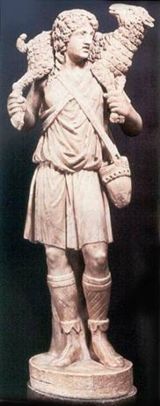
 |
Freethought & Rationalism ArchiveThe archives are read only. |
|
|
#1 | |||
|
Contributor
Join Date: Mar 2006
Location: Falls Creek, Oz.
Posts: 11,192
|
Quote:
The inscription of Abercius Quote:
Ha ha ha ha ha. The Inscription of Abercius speaks of "The Shepherd" not "The Christian". That this allegorical text refers to anything christian is only by way of assumption. For example, there have been a number of different interpretations of Abercius. In 1894 G. Ficker, supported by O. Hirschfeld, strove to prove that Abercius was a priest of Cybele. In 1895 A. Harnack offered an explanation based upon religious syncretism and in 1896, Dieterich made Abercius a priest of Attis. Also the WARNING WARNING WARNING signs need to be clearly flashing because the papal archaeologist De Rossi has his finger prints all over the evidence. Am I a heretic for refusing to confess that this inscription of an "Early Christian Bishop" is not unambiguously Christian? |
|||
|
|
|
|
#2 | ||||
|
Banned
Join Date: Apr 2004
Location: Alberta
Posts: 11,885
|
Quote:
A priest is a shepherd and all he needs to know is hither and thither they go, but is not a Christan for sure and if he was he would never tell either. |
||||
|
|
|
|
#3 |
|
Contributor
Join Date: Mar 2006
Location: Falls Creek, Oz.
Posts: 11,192
|
From my notes ...
Text inscribed into a slab was found in 1882 by an English traveller, W. Ramsay, at Kelendres, near Synnada, in Phrygia Salutaris (Asia Minor). This inscribed slab was bearing the date of the year 300 of the Phrygian era (216 CE). The inscription in question recalled the memory of a certain Alexander, son of Anthony. De Rossi and Duchesne at once recognized in it phrases similar to those in the epitaph of Abercius. On comparison it was found that the inscription in memory of Alexander corresponded, almost word for word, with the first and last verses of the epitaph of the Bishop of Hieropolis; all the middle part was missing. Mr. Ramsay, on a second visit to the site of Hieropolis, in 1883, discovered two new fragments covered with inscriptions, built into the masonry of the public baths. These fragments, which are now in the Vatican Christian Museum, filled out the middle part of the stele inscribed with the epitaph of Abercius. It now became possible, with the help of the text preserved in the Life, to restore the original text of the epitaph with practical certainty. The subject of the epitaph is often identified with a writer named Abercius Marcellus, author of a work against the Montanists, and claimed to be at one time the christian Bishop of Hieropolis, in Phrygia. Some fragments of this work have been preserved by Eusebius. Here is the text from Quasten, Patrology, v. 1, p. 172.
 See Kriophoros (Good Shepherd) The CHRESTOS Shepherd. |
|
|
|
|
#4 |
|
Veteran Member
Join Date: Jun 2010
Location: seattle, wa
Posts: 9,337
|
Another image. This time of mountainman's tediously desperate claims:

|
|
|
|
|
#5 |
|
Contributor
Join Date: Jun 2000
Location: Los Angeles area
Posts: 40,549
|
Early Christian Wriitings has more.
|
|
|
|
|
#6 |
|
Veteran Member
Join Date: Jun 2010
Location: seattle, wa
Posts: 9,337
|
 And you know there are countless inscriptions from that part of the world. I forget where I saw them. But there is a book I once cited of many more Christian inscriptions from Asia Minor. All from the third century. This is like trying to have an argument over the sky being blue. There are many unresolved questions in early Christianity. Whether Christianity can be dated before Nicaea isn't one of them. It's like running into a wall with your head. The fact that you can keep running into a wall doesn't prove that the wall does't exist. It's just the disorientation caused by repeated impact that leads one to a false conclusion. There must have been people in the same predicament at the end of the Roman Empire. The Empire may have been recognized to be corrupt, and those defending it probably admitted it. But the hordes of moronic barbarians trying to climb over the walls were even worse. |
|
|
|
|
#7 | |
|
Contributor
Join Date: Mar 2006
Location: Falls Creek, Oz.
Posts: 11,192
|
Quote:
This claim albeit widely held is tediously desperate. What evidence do you present that the Abercius inscription is what it is claimed to be by the papal archaeologist de Rossi? And Abercius seems to follow the Good Shepherd, or the Chrestos Shepherd. |
|
|
|
|
|
#8 | |
|
Contributor
Join Date: Mar 2006
Location: Falls Creek, Oz.
Posts: 11,192
|
Quote:
The question is whether this inscription is unambiguous evidence of a Christian presence. |
|
|
|
|
|
#9 | ||
|
Contributor
Join Date: Mar 2006
Location: Falls Creek, Oz.
Posts: 11,192
|
Quote:
The Christians for Christians Inscriptions of Phrygia by Elsa Gibson. I have studied the book. The link above is to my review of the data. Quote:
|
||
|
|
|
|
#10 | |
|
Veteran Member
Join Date: Jun 2010
Location: seattle, wa
Posts: 9,337
|
Quote:
|
|
|
|
| Thread Tools | Search this Thread |
|